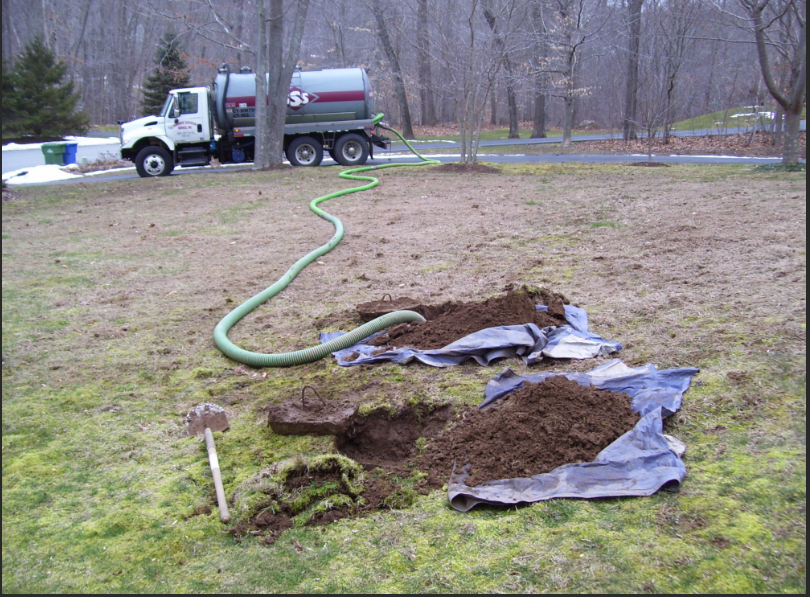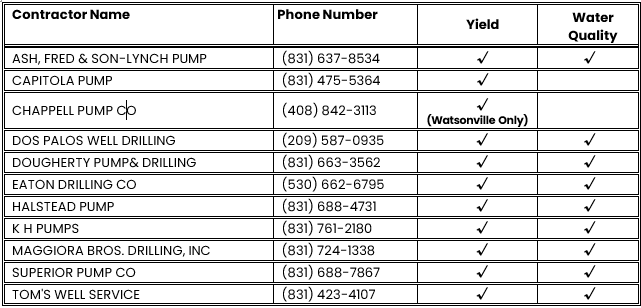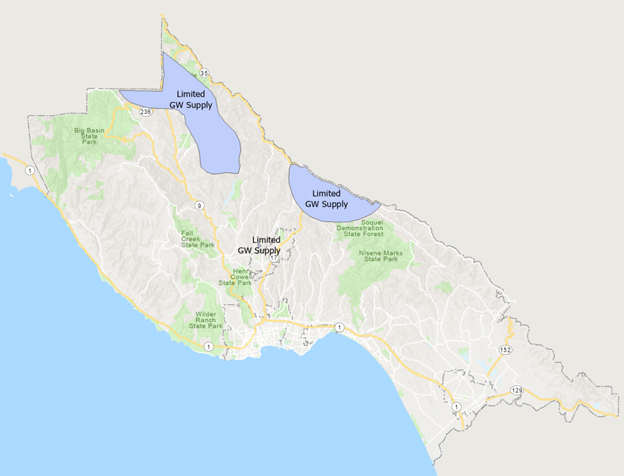Are you planning to buy or sell Real Estate with its own onsite wastewater treatment system or water source?


Real Estate in rural areas often do not receive municipal sewer or water service and must maintain onsite systems to provide those services. Failure of an Onsite Wastewater Treatment System (OWTS, also known as a septic system), or Individual Water System (IWS, domestic well or spring) can be extremely costly, with replacements potentially reaching $100,000. To ensure buyers are informed if the OWTS and IWS are not operating properly, and what kind of repairs or upgrades might be needed in the future, the County created new requirements and recommendations for Rural Real Estate at the time of sale.
IWS Program: NEW REQUIREMENT
Beginning September 1, 2025, when Rural Real Estate is transferred, the IWS must be tested to confirm it has acceptable yield (the amount of water the source can produce) and water quality. The seller is responsible for completing the disclosure form that summarizes the results and providing it to the buyer and the County (County Code Section 7.73.075).
An IWS that doesn't produce enough water or has poor water quality can greatly impact quality of life. Sellers should also be aware of these issues as they could create hurdles during the sale process.
- What are the requirements of the new Time of Sale program?
In 2025, the Board of Supervisors approved changes to the Santa Cruz County Code governing Individual Water Systems (IWSs). Sellers of real property that receive potable water from an individual water system, such as a domestic well, spring, or stream diversion, must now complete water quality and yield testing before a property transfer.
- My home is on a spring, is testing still required?
Yes, testing is required for any property served by an IWS regardless of whether it is a traditional well, a horizontal well, a spring, or a stream diversion.
- I’m thinking of selling my home, when should I have the IWS tested?
As it can take several weeks to schedule, conduct the yield and water quality testing, and receive the water quality results from the lab, we recommend having the testing done as soon as you decide you will put your property on the market.
- Which companies offer these services?
The Environmental Health Division maintains this list as a reference and does not recommend any specific contractor, listed or unlisted.

For Water Quality testing services only, EHD also maintains a list of accredited Water Testing Laboratories and Water System Operators
The State Water Resources Control Board also lists accredited laboratories here: https://www.waterboards.ca.gov/drinking_water/certlic/labs
- What are the expected costs for the yield tests?
- 3-Hour Flow Test: $600-$1,000
- Extended Tests: Additional $165–$185 per hour
- Advanced or Comprehensive Testing: Optional but encouraged by the County; costs typically range from $1,000 to $10,000
- Are there known areas with low well yields?
Yes, the map below shows areas of the County that are known to have wells with low yields. This map can also be found on the County GISWeb under the “Water Resources” layers.

- Which tests are required for the water quality analysis?
- Required:
- Bacteriological analysis for total coliform organisms (presence/absence)
- Select Title-22 Inorganics Primary Contaminants are required, Ref 7.73.070 (B): Aluminum, Antimony, Arsenic, Barium, Beryllium, Cadmium, Total Chromium, Fluoride, Iron, Manganese, Mercury, Nickel, Nitrate, Nitrite, Selenium, Thallium.
- Note: Perchlorate, Cyanide, and Asbestos are Title 22 Inorganics Primary Contaminants. However, those contaminants are not prevalent in Santa Cruz County, and are waived for IWS time of sale testing.
- Conditionally Required:
- Hexavalent Chromium testing is required for wells only that are located South of Valencia Creek
- Chloride, Conductivity, and TDS testing is required for wells only that are in the Coastal Zone and when requested by the County due to known water quality risks.
- Recommended:
- The following contaminants are strongly recommended because they are often included as part of a Title-22 inorganics analysis and are indicators of maintenance requirements:
- Aggressivity, Alkalinity, Bicarbonate, Bromide, Calcium, Carbonate, Color, Copper Hardness, Hydroxide, Langelier Index, Lead, Magnesium, MBAS (Surfactants), Odor pH, Potassium, Silver, Sulfate, Sodium, Turbidity, and Zinc.
- My IWS was tested recently, do I need to test it again?
If the testing was consistent with code requirements, test results less than three (3) years old will be accepted.
- What are the costs for the water quality analysis?
- Monterey Bay Analytical Services:
- Bacteria testing: $28 (contractors typically charge $150–$200)
- Title 22 testing: $340 (contractors typically charge $500-$700)
- Some quoted higher rates for water quality testing (up to $500 for bacteria $1,000 for Title 22)
Approximate Total (including markup): Total: $650 - $900
Why the markup? Contractors generally increase lab costs to cover the full scope of services, including sample collection and delivery, coordination with real estate agents and property owners, and handling time-sensitive requests. They also have limited control over lab processing times, which can vary.
- Are there any options to reduce the cost for the water quality analysis?
There is free well testing available through the Central Coast Drinking Water Well Testing Program. However, testing through this program can take several months, so sellers will have to enroll in the program well before the time of sale
- What is the average timeline for this work to be completed?
Scheduling: 1-2 weeks from initial call to the flow test.
Water Quality Results: An additional 2-3 weeks for Title 22 testing (extended due to lab availability). Total time from initial contact to final results can be 3-5 weeks.
- Once the tests are completed, what do I need to do?
To ensure compliance, the completed disclosure form “Water Source Evaluation upon Transfer of Property” and laboratory report must be provided to the property buyer, and submitted to the Santa Cruz County Environmental Health Division via email at ENVPointofsale@santacruzcountyca.gov
OWTS Program
Beginning July 1, 2023, when Rural Real Estate is transferred, a septic tank inspection report must be completed, and a disclosure form that describes possible concerns with an OWTS must be completed by the seller and buyer (County Code Section 7.38.216).
Sellers of real property must complete a point-of-sale septic inspection report to identify any defects in the Seller’s OWTS and other characteristics of the system. If such inspection shows the OWTS is failing, then repairs that meet the County’s OWTS standards must be completed by the Seller prior to the sale of the Property or the responsibility to complete the repairs within 90 days can be transferred to the Buyer if the buyer agrees and a transfer of responsibility form is completed and filed with County Environmental Health.
- Which properties fall under this jurisdiction?
All properties that are within Santa Cruz County and that are served by an onsite wastewater treatment system / septic system (OWTS).
- What properties are exempt from this requirement?
Properties that are served by public sewer. Undeveloped parcels. Properties that have a new OWTS which was installed under permit within 5 years. Properties that have an OWTS which have been repaired or upgraded under permit within 3 years. Transfers without consideration or transfers between existing co-owners (including but not limited to, gifts between family members, transfers due to death via joint-tenancy, probate transfers, and trust distributions)
- What is the purpose behind this?
Property owners are responsible for maintaining their OWTS. The purpose of the Point-of-Sale Program is twofold: to protect public health and to protect buyers from unforeseen repair and upgrade obligations. Therefore, the Program includes evaluating septic systems, identifying problems and repairing failing systems, locating unknown systems, and making records available to the public.
- Who is responsible for having the Point-of-Sale inspection done?
Prior to the close of escrow, the seller is responsible for the inspection and any required repairs. The responsibility for repairs may be transferred to the buyer by filling out the “Transfer of Responsibility” form.
- Why would a full OWTS evaluation report be needed?
The pumping inspection report is indicative of the condition of the OWTS at the time of the report but may not reflect performance in the past or expected performance in the future. It also does not provide information regarding compliance with current standards or site constraints. It is recommended that this additional information be obtained by hiring an approved provider to prepare a full OWTS evaluation report. (under development)
This is particularly useful if the buyer plans to remodel the home in the future. Depending on site conditions and history, remodels may require an upgrade of the OWTS at a substantial cost and the buyer should be aware of that prior to purchasing the property.
- If my septic tank was pumped recently, is the report still acceptable?
The pumping report must have been completed within 12 months prior to the close of escrow, and it must also include a flow test of the leach field using at least 250 gallons as measured with a flow meter.
- If the report says there are problems with the OWTS, what happens?
Failures or structural defects must be corrected under a permit from EH. Ideally this would be done prior to the close of escrow, but the buyer can choose to accept the responsibility for making the repairs by filing a “Transfer of Responsibility” form with EH.
The work must be completed within 90 days of the close of escrow. The buyer may request an extension if they are making a good faith effort to complete the work, circumstances beyond their control are causing delays, and interim measures are being taken to prevent any public health or water quality impact.
Minor Maintenance issues such as repair or replacement of spetic tank lids, risers, tees, elles, sewer tightlines, pumps, valves, electrical components, or other minor maintenance issues do not need a permit to fix and should be addressed at the time of transfer by either the seller or the buyer. No transfer of responsibility is required for minor maintenance issues.
- What if a pumping inspection report indicates that there is a high operational level, or liquid flow-back into the tank?
A high operational level or liquid flow-back are indicators that the system may not be functioning at an optimal level. No action is required but more investigation is recommended to identify the cause of the problem. These indicators could mean that a failure may be imminent, or the system has a clogged or crushed line taht needs to be addressed.
- Can the responsibility for making repairs to the OWTS be transferred from the seller to the buyer?
The buyer can choose to accept the responsibility for making the repairs by completing and filing a “Transfer of Responsibility” form with County EH. (link to form here) The seller will remain the responsible party unless a “Transfer of Responsibility" form has been submitted and approved by Santa Cruz County Environmental Health (EH).
The work must be completed within 90 days of the close of escrow. The buyer may request an extension if they are making a good faith effort to complete the work, circumstances beyond their control are causing delays, and interim measures are being taken to prevent any public health or water quality impact.
- Can a third party pay for the repair or can it be paid out of escrow?
Nothing prevents a third party or escrow account from paying, but the seller remains the responsible party unless a “Transfer of Responsibility” form has been submitted and approved by EH.
- If there are problems with my OWTS, does that have an impact on the value of the property?
Problems or deficiencies with your OWTS can have an impact on the value of your property and can affect the completion of a sale. That is why it is recommended that you have your OWTS evaluated prior to the sale process so that you are aware of potential issues and can choose to address them early. Prospective buyers can thus be fully informed up front, with less chance of complications later in the sale process.
- What if there is an unpermitted OWTS?
If the OWTS is unpermitted but is working satisfactorily as demonstrated by the pumping inspection report, no further action is required at the time of sale. But the buyer should be aware if the OWTS is unpermitted, there may be limited information in the EH records about the OWTS. Without records, it is more difficult to predict how the OWTS will perform in the future. And, if the new owner wants to remodel in the future, the OWTS will need to be shown to meet standards, by an approved qualified professional, or be upgraded to meet standards under permit. Click here to search the Santa Cruz Environmental Health public records.
- What if there are unpermitted buildings or additions on the property?
If there are unpermitted buildings or additions, the OWTS may or may not meet current standards. If the OWTS is working satisfactorily as demonstrated by the pumping inspection report, no further action is required at the time of sale. However, if the OWTS is undersized, it could become overloaded and fail in the near future.
- What about future changes to the property?
If the new owner ever wants to remodel, the OWTS will need to be shown to meet standards, by an approved qualified professional, or be upgraded to meet standards under permit.
- What if information has been falsified?
A prospective buyer is encouraged to exercise diligence in fully evaluating the OWTS for a home they are considering purchasing. The buyer should not rely on the pumper inspection report done at the time of sale but should also consult the EH records online for history on the OWTS. If there are conflicts in information, the buyer should consider requesting a full evaluation of the OWTS by an approved provider.
- What if an OWTS has been installed on the neighbor’s parcel or vice versa?
An OWTS may be permitted on another property with a recorded document granting the easement. In some cases where property lines may be unclear, a permitted OWTS may have been installed on another property. If the OWTS is installed on another property without an easement but is working satisfactorily as demonstrated by the pumping report, no further action is required at the time of sale. But the buyer should be aware that this could become a civil matter with the other property owner.
- What if an easement for an OWTS on a different property exists?
If the OWTS is installed on an easement on another property, the buyer should evaluate the terms of the easement to ensure that the easement will allow future repair and upgrade of the OWTS.
- What do I need to do if my OWTS is an enhanced treatment system?
Enhanced treatment systems have additional treatment and control components that provide a much cleaner effluent as needed to mitigate site constraints such as high groundwater or limited dispersal area. These more complex systems are required to be regularly inspected and serviced by an approved Onsite Systems Service Provider (OSSP).
When a property with an enhanced treatment system is sold, the buyer must be provided with an inspection report prepared by the OSSP within the 6 months prior to the close of escrow. New owners are required to enter into a service agreement with an approved OSSP at the time of sale. The OSSP will determine if the enhanced treatment system needs to have the tank pumped or not. If the OSSP recommends that the tank be pumped, the 250-gallon flow test is required at that time. If the OSSP determines that the tank does not need pumping, the flow test may be waived.
Recommendations For Sellers
It is recommended that the Seller complete the septic tank inspection form prior to listing the property for sale. That way any system deficiencies can be corrected early without potentially jeopardizing the sale process. The Seller should also consider having a more thorough Point of Sale OWTS Evaluation Report completed by an Approved Provider that can be provided to prospective buyers to help reduce potential delays or hangups in the sale process.
Recommendations For Buyers
Buyers are strongly advised to research the OWTS and IWS documents available in the County Environmental Health Documents. These documents may indicate the condition of the Rural Real Estates current IWS and OWTS along with any conditions on the property that may require the OWTS to be upgraded in the future. Note, pumping reports and flow tests conducted for a septic tank inspection are only indicative of conditions at the time of the pumping and may not indicate past failures, wet season failure, future system performance, or upgrade requirements for future remodels. Buyers are also strongly encouraged to hire an Approved Provider to complete an in-depth OWTS Evaluation Report.
For more information email: ENVPointofSale@santacruzcountyca.gov